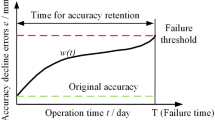Abstract
In large fuselage milling operation the panel may deflect and vibrate due to milling thrust force. A clamp is needed on the opposite side of the panel to limit such effects. The support must be able to withstand the thrust force generated by the milling process. In this paper, a specific model for torus cutter milling force and a general milling force model have been simulated to predict the cutting forces. In order to get higher cutting efficiency, the torus cutter needs to adopt different tilt angle relative to the workpiece which changes the thrust force. An equation has been developed to predict the resulting thrust force on the skin panel at different tilting angle. Simulated thrust force results have been validated against dynamometer readings acquired during milling operation.
Similar content being viewed by others
References
Altintas Y, Lee P (1998) Mechanics and dynamics of ball end milling. J Manuf Sci Eng 120(4):684–692
Balazinski MS, Gravelle, et al (1998) Evaluation of the distance between the machining of assists for the tool tip-ring. 2nd International Conference on Designing and Manufacturing Integrated Mechanical IDMME’98 Compiegne, France: May 27-29 pp 569-575
Chouinard A (2011) Remplacement de l'usinage chimique des tooles aeronautiques minces en aluminium par de l'usinage mecanique. Departement de genie mecanique, Ecole Polytechnique de Montreal. M Sc
Deng H, Melkote SN (2006) Determination of minimum clamping forces for dynamically table fixturing. Int J Mach Tool Manuf 46(7):847–857
Gilles P, Monies F et al (2006) Modelling cutting forces in milling on torus cutters. Int J Mach Mach Mater 1(2):166–185
Gilles P, Monies F et al (2007) Optimum orientation of a torus milling cutter: method to balance the transversal cutting force. Int J Mach Tool Manuf 47(15):2263–2272
Li B, Melkote S (2001) Fixture clamping force optimisation and its impact on workpiece location accuracy. Int J Adv Manuf Technol 17(2):104–113
Liu Z, Wang MY, et al (2012) One fast fixture layout and clamping force optimization method based on finite element method. ASME/ISCIE 2012 International Symposium on Flexible Automation, American Society of Mechanical Engineers
Qin G, Lu D, et al (2009) A slack-based method to clamping force optimization for fixture design. Information and Automation, 2009. ICIA'09. International Conference on, IEEE
Selvakumar S, Arulshri KP, Padmanaban KP, Sasikumar KSK (2010) Clamping force optimization for minimum deformation of workpiece by dynamic analysis of workpiece-fixture system. World Appl Sci J 11(7):840–846
Trappey A, Liu C (1992) An automatic workholding verification system
Wang MY, Pelinescu DM (2003) Contact force prediction and force closure analysis of a fixtured rigid workpiece with friction. J Manuf Sci Eng 125(2):325–332
Xiongand C-H, Xiong Y-L, et al (2003) On prediction of passive contact forces of workpiece-fixture systems. ASME 2003 International Design Engineering Technical Conferences and Computers and Information in Engineering Conference, American Society of Mechanical Engineers
Author information
Authors and Affiliations
Corresponding author
Rights and permissions
About this article
Cite this article
Mahmud, A., Mayer, J.R.R. & Baron, L. Determining the minimum clamping force by cutting force simulation in aerospace fuselage pocket machining. Int J Adv Manuf Technol 80, 1751–1758 (2015). https://doi.org/10.1007/s00170-015-7104-4
Received:
Accepted:
Published:
Issue Date:
DOI: https://doi.org/10.1007/s00170-015-7104-4




